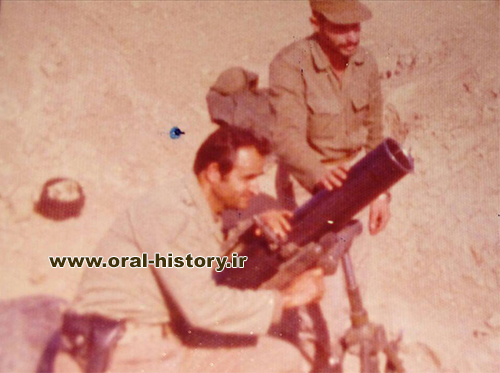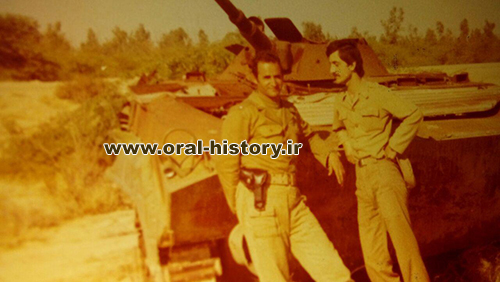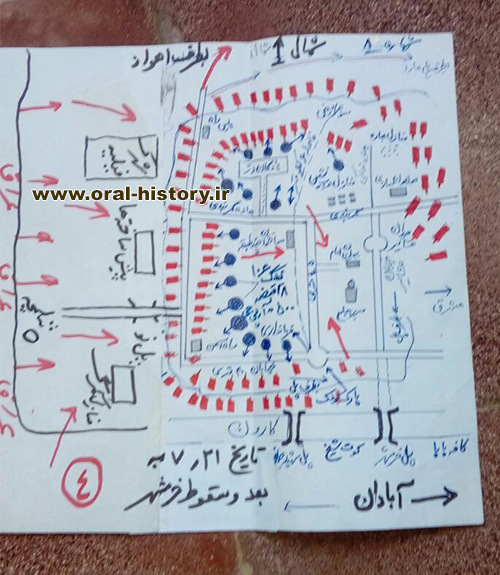The First Day of War
Afsaneh Sadeghi
Translated by: Fazel Shirazd
2018-12-11
Note: The injured Colonel "Ali Ghamari" is the only survivor of 19 battalion officers of Khorramshahr Fortress, and the commander of Khorramshahr Fortress along with other partners at the beginning of Saddam's invasion on our country (Iran); he defended the country's privacy; The battalion, which had to be replaced by a new battalion in 48 hours resisted manfully and jealously the oppression of Saddam Hussein during 34 days with the help of public forces (Basiji and the Guards) and its limited equipment.
* Please introduce yourself briefly!
I am Colonel Ali Ghamari, born in 1944 and from Asadabad. My paternal origin is Kermanshah, but I came to Asadabad, Hamadan. I have been a militant for 54. I've worked for 24 years on the education of war. Before the revolution, I was a commando trainer and I taught 5600 soldiers in this regard. After the revolution, I continued serving in the army and went to Kurdistan in 1979. After the liberation of Kurdistan, I went to Khuzestan on personal preference and introduced as the commander of the 1st Company of Khorramshahr fortress.
*What was your reason to join the army?
When I was child I was very active and busy; even when I was 13 to 14, I used to go hunting, and many times wolf attacked me. In fact, the army is a place where you have to have a lot of work; as if, I was born for the army. When I got to the age of military service, I wasn’t in legal age –about 6 months younger - to register. Sergeant major Parvaneh, was responsible for sending troops; he told me: "I must have a subscription from my dad." Because my dad was illiterate; I wrote subscription as my father's order, and, I fingerprinted on the letter and delivered it. They accept the letter without investigation. In the training course, we went toward Khorramabad Garrison next to Falak-ol-Aflak castle by an American Rio truck. They were supposed to choose soldiers for Iran's Imperial Guards and send them to Tehran. For the guard, people who had 180 cm in height were chosen. My height was 170 centimeters; among 27 my townsmen, 8 people were chosen. I'm very upset about this. After an hour and a few hours, I heard the words of sergeant major Vazin and Captain Haghgo, who was responsible for sending soldiers to Tehran. The next day, I went to Captain Haghgo and told him that Vazin ordered to write my name as a chosen person. To prove my words, I told him I spoke about current situation and moving to Tehran in next day; He accepted me. We went to Tehran. When we arrived at the garrison "the King Garden of Tehran" the garrison's officer line all the soldiers up. I was very worried that the problem of my height would be revealed there. When the commander was reviewing the soldiers, he looked at me, he caught my ears and said, "Who gave you permission to come here?" After that, he went to the stand and asked everyone to run twenty times around square. I got first among soldiers in all 20 rounds. The commander, watching this ability, made me the chief of all the soldiers. After military service ended, they suggested that I enter the army. Since I was also very interested in myself, I accepted the offer. Before the revolution, I participated in different commando courses and trained people. After the revolution, I still served in the army.

Left: Colonel Ali Ghamari
⃰After the Islamic Republic Revolution, when did you go Kurdistan?
When Imam Khomeini (RA) said that you should release Kurdistan, I was among the first units was sent to Kurdistan on September 6, 1979. The most important thing that happened at the end of my mission in Kurdistan was the attack on Komala party[1] forces while we were returning to Tehran. Our mission to the command of Colonel Sharif Ashraf on the day of Eid al-Ghorban[2] in November 1st, 1979. On the way back to Tehran, we moved from Sardasht. Near arrived in Baneh and a cemetery at noon. It was pretty cloudy. Because it was the day of Eid[3], most people came to the graveyard. The Komala party was lying in ambush on the right side of road. They were wearing womanly and loose clothes and hid themselves in crowd. With this trick, they hid their rifles and RPGs under their clothes. As our unit reached to the cemetery, the conflict began; so, 86 cars, that we had, were destroyed. About 30% of people were martyred, such as Colonel Ashraf, who was our commander, was mercilessly martyred. After this, I served 6 months in Tehran. After 6 months, I went to the South Front at my request.
* What did you choose South Front?
Before the Revolution, I had an experience in serving on the south front and fighting with Iraq during the years 1968, 1969 and 1974. In 1974, we had camps in the boarder of Iraq for a week.
* When did you go to Ahvaz?
On the 2nd of Farvardin 1980, I got command to move towards Ahvaz along with three of my friends on the 25th of March of the same year. After we arrived in Ahvaz, we first slept in a hotel. Then we entered the 92th Armored Division of Ahvaz. They said to us: "Because Khorramshahr has no officer, we, four people, must go to Khorramshahr ". In those days, the Chief of General Staff was not able to provide a car and driver to take us to Khorramshahr. We took two of our Buick cars and we went to Khorramshahr at a personal expense.
*What was your post in Khorramshahr?
I was the commander of the 1st troop of Fortress Battalion in Khorramshahr, range from Shalamcheh to the Fortress 14 and about 35 kilometer toward Iraq's boarder line. When I was stationed in the Khorramshahr garrison, it was so weak in terms of discipline that I did not have the permission to order a soldier; I was even threatened. Seeing the situation, I arrived in the city to provide the basic equipment. Helped by the father of martyr Jahanara, who was one of business men, as well as the mayor of Khorramshahr, we provided some basic equipment (beans, tea, sugar, flask...) and took it to the garrison. Soldiers liked me by seeing this movement. After that, I tried to arrange it there.
* What was the borderline situation before the war began?
I was watching the movements of the Iraqi people for six months, when I was the commander of that troop. They were continuously shooting from the border areas, sometimes by mortar shells. During this period, I wrote to the authorities and wrote the shortcomings and provocations of the Iraqis. Before the start of war, I used to travel to Iraqi border guards, and had breakfast with them; some of them were Iranians, and they were telling me about Saddam's preparations for the war and intention to attack. They worked on the borderline with bulldozers all times. When I wrote to the authorities, they replied: "They are making roads in their own country."
* During that time, was there a direct conflict?
On May 22nd, 1980, the fighting started seriously. June 5, 1980 Mousavi Bakhtour and Abbas Farman, two of our soldiers at Khin police station walking on the border Iraqi were shot and martyred by Iraqi forces. 17 people of my troops were martyred and 28 ones were injured before the official start of war. In order to look more closely at the situation, on the night of June 6, 1980, along with the captain Zareans, we entered the Iraqi territory to identify 5 km to the right of the police station in the 2nd Fortress, where the Iraqis did not have a garrison there. We put a mattress on the barbed wires and walked about 500 meters forward. There was a tank in front of us. We went ahead slowly. There were other tanks and personal carriers. That night we recorded information about 16 battalions and artilleries. I also picked up the label of Battalion 91 and the Brigade 130 to show authorities.

Left: Colonel Ali Ghamari
* Where were you at the beginning of the war?
A group of 45 people from my group was stationed there to protect Minoo Island. So, before the conflict began, I went to Minoo Island at 10am on Sept 22. The Iraqi people who were standing in front of our garrison on the island, took Iranian flag from the borderline and fired it in order to make Iranians angry. Even they cleaned their nose with it. The same thing provoked the comrades. I went there to stop conflict and talk with troops. At 12 noon, I returned to command station at 8 km. I was sitting in my office. I told one of my soldiers to bring me a lunch. When he brought food, and eating first spoon of the food, Captain Rustami telephoned me from Ḥudūd police station about 12 and 20 minutes. His sound was shaking. When I asked him what happened? He replied: "Mr. Colonel, the tanks you have already talked them, are coming toward to us." I said: "Do not be afraid, get out weapon 106 quickly and get ready!" I immediately contacted all the fortresses and barricades and announced for readiness. Of course, they also realized the attack. Only the artillery did not notice, because the air was warm and they were back to rest. I told everyone by phone: "prepare weapon 106! And if the Iraqis even touch border's barbed wires, you will be allowed to shoot. I immediately got on the jeep and went to police station. The enemy tanks stood at 80 to 100 meters behind borderlines. Iraqis prepare loader and bulldozer every 50 to 60 meters put out mines. When I saw the first loader that started spade behind barbed wires, I immediately went to weapon 106 and fired into one of the tanks; it was the first tank that was destroyed when the war started. After that, I got on the jeep and returned to central fortress to guide units by the phones. All the barricades were defending. In the same situation, I ordered some of my soldiers to record whatever was happening, and to deliver my secretaries at the central fortress at night.
* How much was your equipment at the time of the war?
The time of the war, as I had already talked and sent letters, and by the help of General Qasem Ali Zahir Nejad, we were received 8 tanks. We destroyed 17 Iraqi tanks in the same month September 22nd, 2018, and by the same eight tanks. These 8 tanks were available for our battalion. In my order, I quickly took out the tanks and started firing. Our first tanks were destroyed around 2 pm and 10 pm by Iraqi tanks. About 50-55 Iraqi tanks were firing at one of our tanks at the same time. By the end of the conflict of that day, all 8 of our tanks destroyed; all drivers were killed. After that, we gathered a number of martyrs and wounded people and turned back quickly.
*How long did the conflict last?
At 8:00 PM, the conflict with the Iraqi people was ended. Only their personal carriers were working. After the conflict ended, the Iraqis listen Arabic music behind the borderline and began to drink and dance.
* What did you do?
It was around 9:00 or 10:00 PM when it came to my mind to use a plan to make less losses in terms of defenses. I made essential order. I said: "Until the secondary order, all the comrades who are in fortress, find a groove and fall behind it. Each one should be situated in a distance at least 30 people away." Sergeant major Karami was with me likewise; when he asked why I'm doing this, I replied:" by this plan, instead of 10 people, just one person might be martyred." We had to defend ourselves during 24 hours of day until aid forces would come there. I also ordered those who used of weapon106 to stand behind the weapon by only one person, because if it was shot by enemy, at least one person might be martyred. By this plan, the Iraqis could not enter our territory from the line that was in our command until the third day of the war. We were involved with this plan until the morning.

* When was the attack started again?
In the morning around 6 and a half, about 30 to 40 Iraqi aircraft fired the Persian Gulf from Abadan. We thought they were insider planes. These planes shot all our six ammunition depots in the Central Fortress Station.
Only 105 balls and 86 bullets were left for us. For the Iraqis think that we still have artillery, I ordered shot a bullet to Iraqis every quarter of an hour.
* When did aid forces arrived in there?
The first aid we received in the same day was at 7 o'clock in the morning with a Buick machine and a personal American Chevrolet with several vans. By the third day of the war, 28 cars helped us. I ordered that if Iraqis approached 100 yards to weapons 106, they shot a bullet for them and a bullet for ammunition and destroyed them so that Iraqis didn’t reach to the weapons. We destroyed 60 Iraqis weapons by our 80 pieces of weapon 106. In this way, we were able to defend the land of our country (Iran) on the first day of Iraqi imposed war against Iran.
Thank you for accepting my invitation
[1] The Komala Party of Iranian Kurdistan, commonly shortened to Komalah, is an armed communist ethnic party of Kurds in Iran. The group is currently exiled in northern Iraq. Komalah has been engaged in guerrilla warfare against the Iranian government, notably during the 1979 Kurdish rebellion and the Iran–Iraq War.
[2] It is also called the "Festival of Sacrifice", is the second of two Islamic holidays celebrated worldwide each year, and considered the holier of the two. It honors the willingness of Ibrahim to sacrifice his son as an act of obedience to God’s command.
[3] Holyday
Number of Visits: 6532
http://oral-history.ir/?page=post&id=8222
